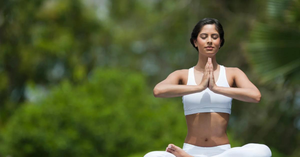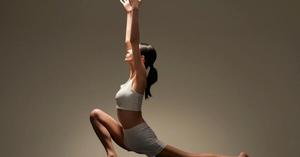“When the breath flows, the mind slows and in that stillness, the body finds its quiet strength.”
Modern life rarely gives us permission to pause. Between work, relationships, and personal expectations, our bodies often carry the weight of mental stress, hormonal fluctuations, and fatigue. Yoga offers a gentle way to reconnect not through effort, but through ease.
A relaxing yoga flow is more than a series of postures. It is a rhythmic dialogue between your body and breath, a practice that allows emotional release, physical comfort, and deep nervous system relaxation. Especially during your luteal or menstrual phase, these poses support circulation, calm the mind, and help you feel more grounded.
I once met a young woman, Riya, who used to dread her premenstrual week. She would describe it as a “cloudy zone” filled with irritability and cramps. When she began ending her evenings with a 15-minute restorative yoga flow, everything changed. Her sleep deepened, her cramps reduced, and she described feeling “at peace in her own body” , something she hadn’t felt in years.
Her story beautifully mirrors what science has now validated: mindful movement and deep breathing reduce stress hormones, ease muscle pain, and release serotonin, the happiness hormone.
1. Reduces Cortisol and PMS Symptoms:
Studies published in Complementary Therapies in Medicine (2020) show that women who practiced yoga regularly reported reduced premenstrual anxiety, irritability, and fatigue. Yoga activates the parasympathetic nervous system, which calms the “fight-or-flight” response.
2. Improves Circulation and Reduces Cramping:
Gentle inversions and hip-opening poses promote blood flow to the uterus, easing menstrual discomfort and improving oxygen delivery to tissues.
3. Supports Hormonal Balance:
Breath-linked postures improve vagal tone helping the endocrine system stabilize hormones and improving mood regulation.
4. Encourages Emotional Release:
Certain poses, especially hip openers and heart-openers, allow trapped emotional tension to dissolve. Many practitioners report crying or feeling emotionally lighter after these flows, a sign of deep nervous system healing.
This flow can be practiced at any time of day. Use a mat or soft surface, dim lighting, and optional soothing music. Focus on breathing deeply, inhale through the nose, exhale slowly through the mouth.
Sit comfortably with legs crossed, spine tall. Rest your hands on your knees, close your eyes, and breathe deeply. Inhale peace, exhale tension. This sets the tone for inner stillness.
Come to all fours. Inhale, arch your back (Cow); exhale, round it (Cat). Move slowly, syncing each motion with your breath. This eases stiffness in the back and releases emotional heaviness stored in the spine.
Spread your knees wide, bring your big toes together, and rest your forehead on the mat. Stretch your arms forward or beside your body. Breathe into your lower belly, this pose calms the nervous system and relaxes the hips and back.
Lie on your back, join the soles of your feet, and let your knees drop open. Place one hand on your heart and one on your abdomen. This restorative pose relieves pelvic tension and promotes emotional grounding.
Lie close to a wall and rest your legs vertically against it. Keep your arms open beside you. Close your eyes and take slow, rhythmic breaths. This gentle inversion reduces swelling in the legs, improves circulation, and deeply soothes the mind.
Sit with your legs extended, inhale to lengthen your spine, and exhale as you fold forward. Allow your body to rest naturally without forcing. It quiets the mind, relieves anxiety, and releases tension in the hamstrings and back.
Lie flat on your back, arms relaxed by your sides, palms facing upward. Close your eyes. Breathe naturally, letting go of all control. This pose integrates the calmness of your practice, promoting full-body and emotional relaxation.
Beyond flexibility, this flow helps reframe your emotional relationship with your body. Each slow inhale invites compassion; each exhale releases self-criticism. Over time, you start noticing that the same patience you practice on the mat spills over into your daily life.
Women often describe this flow as “a soft hug from within” , a space where they can simply be without judgment.
When practiced regularly, a relaxing yoga flow becomes a sanctuary, a time to restore calm, honor your body, and reconnect with your inner rhythm. It helps regulate mood, relieve PMS tension, and guide you gently back to emotional balance.
As you end your session, remember:
“Yoga doesn’t ask you to be perfect. It simply invites you to be present.”
About PeriodSakhi
PeriodSakhi is your trusted companion for understanding your menstrual health. With easy-to-use tools, it helps you track your periods, ovulation, fertility, moods, and symptoms, while providing insights into your overall reproductive and hormonal health. PeriodSakhi also serves as a supportive online community where women can share experiences, find reliable information, and access expert-backed guidance on menstrual health, PCOS, pregnancy, lifestyle, and more.
Disclaimer
The views, thoughts, and opinions expressed in this article/blog are solely those of the author and do not necessarily reflect the views of PeriodSakhi. Any omissions, errors, or inaccuracies are the responsibility of the author. PeriodSakhi assumes no liability or responsibility for any content presented. Always consult a qualified medical professional for specific advice related to menstrual health, fertility, pregnancy, or related conditions.
Start the conversation
No comments yet. Start the conversation by leaving the first comment!





